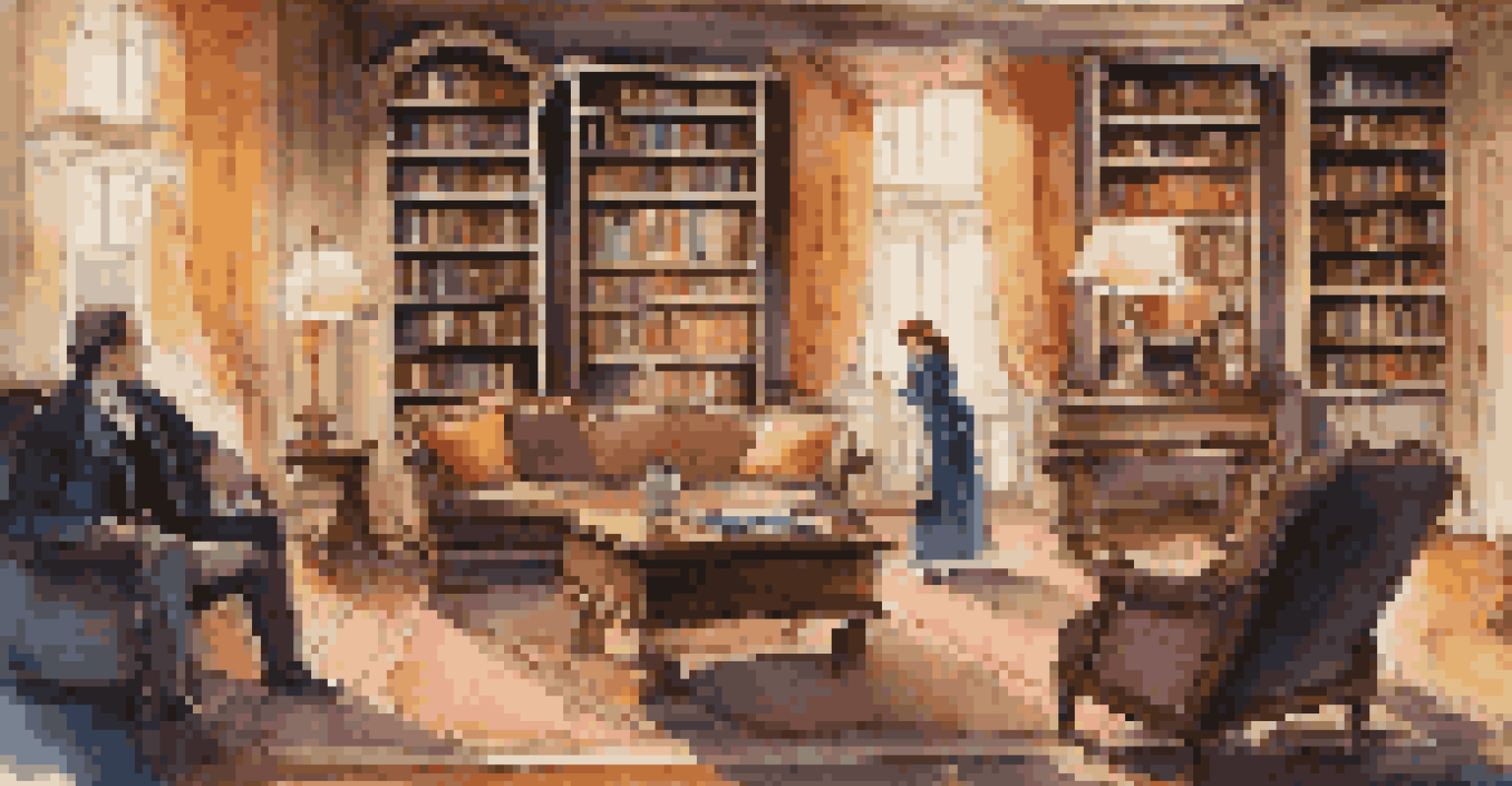Exploring Literary Adaptations: Books to Film and Beyond

Understanding Literary Adaptations and Their Appeal
Literary adaptations bring beloved books to life on screen, capturing the essence of the original story while introducing it to a new audience. This transformation appeals to many; after all, who wouldn't want to see their favorite characters portrayed by talented actors? In essence, adaptations serve as a bridge, connecting readers to visual storytelling.
Books are a uniquely portable magic.
The allure of adaptations often lies in the emotional journey they provide. When a reader has a deep attachment to a book, seeing it adapted can evoke nostalgia and excitement. These adaptations often spark conversations about the book, allowing fans to delve deeper into its themes and characters.
Moreover, adaptations can breathe new life into a story, offering fresh interpretations and perspectives. Directors and screenwriters can explore different aspects of the narrative that may not have been emphasized in the book, enriching the audience's understanding and appreciation of the original material.
The Process of Adapting Books to Film
Adapting a book into a film is no small feat and involves a careful balance between fidelity to the source material and the creative liberties of filmmaking. Screenwriters often face the challenge of condensing complex plots and characters into a limited runtime. This often leads to the elimination of subplots or characters that, while integral to the book, may not serve the film's pacing.

Directors and producers also play a crucial role in the adaptation process. They must decide how to visually represent the narrative, which can significantly alter the tone and feel of the story. For instance, a dark, atmospheric novel might become a vibrant, action-packed film, causing debate among fans about its authenticity.
Adaptations Connect Readers and Viewers
Literary adaptations serve as a bridge between books and visual storytelling, inviting new audiences to experience beloved stories through film.
Ultimately, the success of an adaptation depends on collaboration among the creative team. When everyone shares a vision for the project, it can lead to remarkable interpretations that resonate with both readers and viewers, creating a shared experience that transcends mediums.
Iconic Literary Adaptations That Shaped Cinema
Some adaptations have left an indelible mark on cinema, becoming cultural touchstones. For example, 'The Godfather,' based on Mario Puzo's novel, is often hailed as one of the greatest films of all time. Its portrayal of complex family dynamics and moral dilemmas captivated audiences and redefined the gangster genre.
The best adaptations maintain the spirit of the original while finding new ways to explore its themes.
Another notable example is 'To Kill a Mockingbird,' which not only brought Harper Lee's poignant narrative to life but also sparked discussions about racial injustice. The film's emotional depth and powerful performances have made it a lasting classic, teaching generations about empathy and morality.
These iconic adaptations demonstrate the potential for films to elevate literary works, creating a dialogue between the two forms. They show how stories can evolve while retaining their core messages, inviting new audiences to engage with the literature.
The Challenges of Staying True to the Source Material
While adaptations can be magical, they often face the tough task of remaining faithful to the source material. Fans of the original work may have strong opinions about how characters should look or behave, leading to scrutiny of every creative choice. This pressure can create a challenging environment for filmmakers who want to honor the book while also creating a compelling cinematic experience.
Moreover, certain elements of a book may simply not translate well to the screen. Internal monologues, for example, can be difficult to portray visually without coming off as clunky or tedious. Filmmakers must find innovative ways to convey these thoughts through dialogue or visual cues, which can lead to creative interpretations that differ from the original narrative.
Streaming Services Transform Adaptations
The rise of streaming platforms allows for deeper storytelling and broader representation of diverse narratives in literary adaptations.
Ultimately, the balance between fidelity and creativity can result in mixed reactions from audiences. While some viewers appreciate the fresh take, others may feel that significant themes or character arcs have been lost in translation.
The Rise of Streaming Services and Adaptations
In recent years, streaming services have revolutionized the landscape of literary adaptations. With platforms like Netflix and Amazon Prime investing heavily in original content, there’s an increasing opportunity for lesser-known works to find their way to screens. This trend allows for a wider range of stories to be told, including those that may have been overlooked by traditional studios.
Streaming adaptations also provide the advantage of longer formats. Series adaptations can delve deeper into the source material, allowing the development of characters and subplots that might have been sacrificed in a two-hour film. This expanded format can lead to richer storytelling and a more satisfying experience for fans of the original work.
Moreover, the global reach of streaming services means that adaptations can now cater to diverse audiences. By exploring stories from various cultures and backgrounds, these adaptations can foster a greater appreciation for literature from around the world, breaking down barriers and enriching the viewing experience.
Exploring Adaptations Beyond Film: Theatre and Podcasts
While film adaptations often steal the spotlight, other forms, such as theatre and podcasts, also offer unique interpretations of literary works. Theatre adaptations can provide an intimate experience, allowing audiences to engage with the material in a visceral way. The immediacy of live performance often brings a fresh energy to the story that can be truly captivating.
Podcasts, on the other hand, have emerged as a modern medium for storytelling. With serialized formats, they can explore narratives in-depth, offering commentary and discussions alongside the adaptation. This format allows for a blend of storytelling and analysis, inviting listeners to engage with the material on multiple levels.
Diverse Formats Expand Literary Reach
Adaptations in theatre and podcasts demonstrate the versatility of storytelling, enabling audiences to engage with literature in innovative ways.
Both theatre and podcasts highlight the versatility of literary adaptations, demonstrating that stories can transcend traditional boundaries. By exploring different formats, audiences can connect with literature in innovative ways, broadening their understanding and appreciation of the original works.
The Future of Literary Adaptations: Trends to Watch
As we look ahead, the future of literary adaptations seems promising, with several emerging trends on the horizon. One significant trend is the focus on diverse voices, as filmmakers increasingly seek stories from underrepresented authors. This shift not only enriches the adaptation landscape but also reflects the changing dynamics of our society.
Another trend is the rise of interactive storytelling, where audiences can engage with the narrative in unique ways. This could involve choosing different paths for characters or even participating in the storytelling process. Such innovations could redefine how adaptations are consumed, making the experience more immersive and personal.

Finally, the integration of technology in adaptations—such as augmented reality or virtual reality—presents exciting possibilities. These advancements could allow audiences to experience stories in entirely new dimensions, blending literature with cutting-edge technology to create unforgettable experiences.